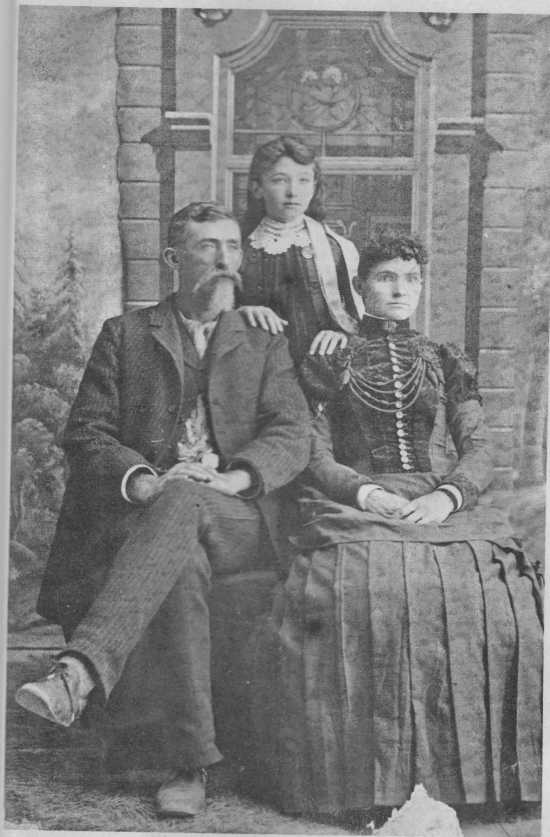Gale Baldwin and the killer of Wild Bill Hickok
Monday, July 2, 2018

Hitchcock County Sheriff Gale Baldwin, his wife and daughter
File photo
In 1923 Gale Baldwin sat down to write his recollections of the early days of Southwest Nebraska for the Hitchcock County paper. At that time Mr. Baldwin was 76 years of age and had a good deal to say about his adventures in the “good old days”. Baldwin had first come to the region from Iowa in 1871, with his wife and two small children. They came in a covered wagon drawn by two mules. Gale was on a hunting expedition---to shoot buffalo, but more importantly, to find a “home”.
The Baldwins spent that first summer of 1871 in Kansas, along the Soloman River, but eventually they moved north across the Republican River into Nebraska and journeyed down the Republican River Valley from about where Stratton now stands, to Arapahoe, where they camped through the winter, until March of 1872. Evidently they found Nebraska to their liking, because by spring they had decided to take up residence in Hitchcock County. During this time they were joined by four of Gale’s old schoolmates from Iowa, Lafe Talkington, Sam Talkington, John Miller, and George Foster, who also planned to settle in Hitchcock County. Gale and his friends were joining Charles and George Gessleman, who were already “old timers” living in their own “dugouts”, in which they had spent the winter in relative comfort.
About May 1st, 1872, before the Baldwins could entirely complete their own dugout, the rains came with a vengeance, and Blackwood Creek flooded, endangering the entire area. The Baldwins’ dugout was leaking water, but Gale managed to “bank up the door” and kept most of the water out. Said Mr. Baldwin, “If the water had rose a foot higher, it would have swept us all off the face of the earth, and that would have meant a big part of Hitchcock County’s population”.

Wild Bill Hickok’s Assassin, “Curly Jack” McCall
John Kleven, Don Hagen, Eben Bacon, and John Murphy had recently come into the area, settling some 6 miles upstream, along the Blackwood and Mr. Baldwin feared that they had been swept away in the flood. As soon as Baldwin had settled his family he set out to search for the men, and was relieved to find them in the treetops, surrounded by water, but safe, though some of their horses had been lost in the flood. 100 soldiers from Fort McPherson, patrolling in the area, were not so fortunate. Six of the soldiers from that unit were lost in the flood.
In those early days the settlers were in more or less constant fear of the Indians, more from their stealing food and equipment from their dugouts, rather than fear of bodily harm---but not always. In 1873 Mr. Baldwin returned to Iowa to clear up some business (and to bring back a sewing machine for Mrs. Baldwin---the first ever seen in this region). While he was gone a band of Sioux warriors raided the Baldwin dugout, making off with everything they could carry, including a great deal of arms and ammunition. Mrs. Baldwin and her children were at home alone but saw the Indians coming and attempted to escape into a nearby grove, but the braves caught up with them and herded them back (“herding us like cattle”). Mrs. Baldwin was sure that they would all be killed anyway, so when the Indians attempted to take away her son with them, she ran with the boy, screaming at a couple of white horsemen who were coming toward the dugout. That was enough. The Indians fled from the vicinity with their loot, but Mrs. Baldwin and her children were saved from becoming hostages. Said Mr. Baldwin, of the event, “I dread to think what would have happened if those men had not come.”
Six days later Mrs. Baldwin and her sister stood on the roof of their dugout and watched the smoke and heard the shots coming from the great Sioux/Pawnee battle at nearby Massacre Canyon, where the Sioux virtually annihilated a band of Pawnee buffalo hunters, their women and children. Baldwin assumed that the Sioux had used his stolen Sharps rifle and ammunition in that battle. Later, while on a freighting trip to the Red Cloud Agency, Mr. Baldwin met a Sioux warrior, who had been present at that last great fight between Indian tribes. He reported that the Sioux had lost but 6 men in the battle.
In 1872, Will Taylor and several other officials of the Lincoln Land Company (the real estate arm of the Burlington Railroad) came into the area to organize Hitchcock County. In the very first election Gale Baldwin was elected Sheriff of the new county. Lew Carr was elected County Judge, Will Taylor County Clerk, Lem Corington, Surveyor, and John Klevin, W.W. Kelly, and George Geselman, County Commissioners.
Two years later all County officers ran unopposed, except for the office of Sheriff. Baldwin was opposed by one, Jack Grimes, who was backed by a gang of horse thieves and cattle rustlers---(a rough bunch who went by the names of “Big Jack”, “Curly Jack” (Jack McCall), “Fat Jack”, and “Long Jack”. These men attempted to swing the election to their man by threatening to kill reluctant voters. As the election approached, they even threatened to kill Sheriff Baldwin.
Mrs. Baldwin believed that carrying guns would only provoke trouble and had persuaded her husband to leave his 6-shooter at home. Baldwin was at a meeting at the Sheriff’s office when Curly Jack came looking for the Sheriff, calling for Baldwin to “come out and fight”. Unarmed, Baldwin called for Jack to “come in and get me”.
Jack came into the office, a gun in each hand, as Sheriff Baldwin waited behind the door. As soon as Curly Jack crossed into the room Baldwin hit him in the head with a four-foot length of “two by four”. Baldwin recalled the incident years later, “He dropped like a log, not even so much as pulling a trigger”.
Dr. Banderslice, Trenton’s doctor, pronounced Curly Jack dead and his body was wrapped in a buffalo robe. When Candidate Jack Grimes, arrived to see the body of his friend, they found that Curly Jack was still alive. Thereupon, Sheriff Baldwin took him into his own home and Mrs. Baldwin, acting as nurse, cook, and housekeeper, brought Curly Jack McCall back to health over the next two months.
The election for Sheriff proceeded on schedule. Baldwin and Grimes each got 7 votes, leaving it to the County Commissioners to break the tie. The Commissioners decided that Baldwin should be retained as Sheriff for another term.
Defeated Sheriff Candidate Grimes left Hitchcock County soon afterward. He drifted off to North Platte, got mixed up in a wild crowd, and was killed in a gunfight.
Curly Jack recovered sufficiently---enough that he was able to rejoin the other Jacks in their camp. Then, he too left Hitchcock County. He was drawn by the lure of riches and excitement of the gold fields in the Black Hills of South Dakota. Two years later, in 1874, Curly Jack gained the notoriety he craved, when he shot and killed the famous “Wild Bill” Hickok in a saloon in Deadwood, South Dakota. He had gained the fame he sought so desperately and even went free after his crime. He was declared innocent in an Indian Territorial Court, by a jury made up of miners and misfits---some of them fugitives from justice themselves. But eventually Curly Jack’s constant boasting of his horrendous deed led to his arrest, and he was retried, in a US Federal Court, for the murder of Wild Bill Hickok. He was hanged at the Federal Penitentiary at Yankton, SD.
After one more term of office, Sheriff Baldwin gave up the law enforcement business and became a freight man, hauling supplies in an oxen-drawn wagon, from North Platte to the Red Cloud Agency near Fort Robinson, in Northwestern Nebraska.
He and Mrs. Baldwin later returned to Hitchcock County, to their home and farm at Range 32, in 1879. They celebrated their 55th Wedding Anniversary in 1923. At that time Baldwin was quoted as saying, “…we have made a host of friends since we came here, and lost none---only to death”. Death came to Sheriff Baldwin on May 13th, 1925.
Source: Gazette Nebraska Centennial Edition, 1967

